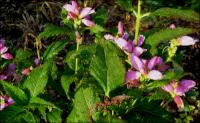Description
Rich pink turtlehead shaped blooms in fall
Rich pink turtlehead shaped blooms in fall
Rich pink turtlehead shaped blooms in fall
Violet racemes all summer through fall
Size: 36” x 12”
Care: Sun, well-drained soil
Native: Southern Europe
Both the Latin and common names are related to flax. Linaria comes from “linum” which is Greek for “flax” and toadflax includes the word “flax.” The leaves of Linaria purpurea resemble flax leaves. According to 17th century English herbalist, John Parkinson, the plant “causes one to make water.” Grown by English plantsman and explorer, Tradescant the Elder, 1634.
Golden daisies waive at the sun from July to September, its cup shaped leaves hold water where butterflies drink & bathe
Can not ship to: Connecticut and New York
Size: 7’ x 3’
Care: full sun to part shade in moist to moist well-drained soil
Native: Central North America, native to Wisconsin.
Awards: England’s Royal Horticultural Society Award of Merit
Sap used by Native Americans to chew and freshen breath. Also used to cure colds, neuralgia, fever, and liver disorders. The Chippewa used it to stop lung hemorrhaging, menstrual bleeding, and cure chest pain. Winnebago drank a potion from the plant to purify themselves before a buffalo hunt. For the Iroquois it cured paralysis, prevented children from seeing ghosts and illness caused by the dead. Lakota Sioux children sometimes chewed resin like chewing gum. An infusion of the whole plant is used to rid horses and humans of intestinal worms. An infusion of the leaves is used to loosen phlegm in the lungs. Described and classified in 1753.
OUT OF STOCK
Sprays of large, single warming yellow daisies, blushed with apricot top a bushy mound of light green leaves, blooms late-summer to late-fall
Size: 1-2’ x 2-3’ and spreading
Care: Full sun to part shade, tolerates normal, sandy or clay soil
Wildlife Value: Attracts bees, butterflies and birds. Deer resistant.
One of the rubellum hybrids, Hybridized in the 1930’s
OUT OF STOCK
Outfacing, white, waxy cup-shaped flowers resembling single roses in late winter, evergreen leaves.
Size: 12-20” x 12”
Care: part shade in moist well-drained soil
Native: rocky places in Europe
Awards: Received Royal Horticultural Society Award of Merit.
The name Helleborus is Greek from hellein meaning “to kill” and bora meaning “food” referring to the plant’s poisonous qualities if placed in food. This species is ancient – known as long ago as 300 BC in Greece where it “purged and cured the mad or melancholicke daughters of Praetus with the roots thereof.” (Parkinson, 1629) Grown in the Eichstätt Garden, the garden of Johann Konrad von Gemmingen, prince bishop of Eichstätt in Bavaria, c. 1600. In Middle Ages petals thrown on floor to drive out evil and ward off power of witches. English herbalist John Gerard (1545-1612) strangely recommended it for curing poisoned animals. Sorcerers made themselves invisible by tossing the powdered plant in the air.

